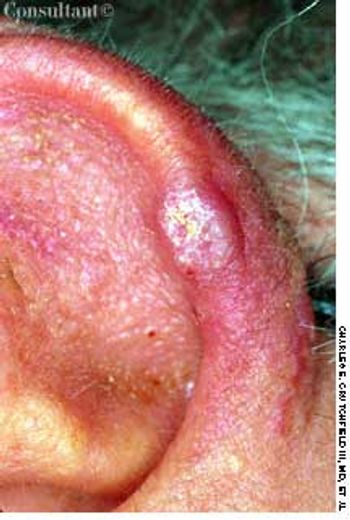
A 61-year-old man with a history of squamous cell carcinoma was concerned about a tender nodule on his ear. He complained of exquisite tenderness with pressure, such as when lying on the affected side at night.

A 61-year-old man with a history of squamous cell carcinoma was concerned about a tender nodule on his ear. He complained of exquisite tenderness with pressure, such as when lying on the affected side at night.

Following two witnessed tonic-clonic seizures, a 65-year-old woman with a history of chronic obstructive pulmonary disease was admitted to the hospital. Results of laboratory studies included serum creatinine level, 2 mg/dL; blood urea nitrogen level, 28 mg/dL; and erythrocyte sedimentation rate, 61 mm/h. The patient's antinuclear antibody (ANA) titer was 1:40 with a speckled pattern, and creatinine clearance was 17 mL/min. An ultrasonogram revealed bilateral small kidneys. CT and MRI of the head revealed no abnormalities.

For 2 months, a 22-year-old uncircumcised man noticed an asymptomatic, erythematous, static lesion on the glans penis. He had applied an over-the-counter “jock-itch” ointment for 2 weeks but to no avail. The young man was otherwise healthy and denied having dysuria or a history of sexually transmitted disease.
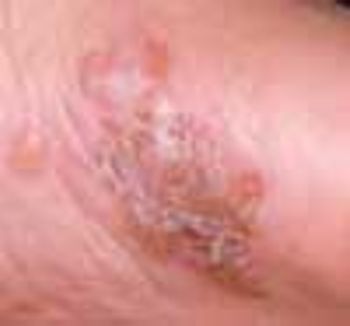
A 24-year-old man presented for evaluation of pruritic vesicles on both feet. Ten days earlier, dyshidrotic eczema had been diagnosed by another physician who prescribed triamcinolone ointment. The patient reported that the foot eruption worsened after the topical medication was applied.

This 6-year-old boy was brought to his physician for evaluation of a rash. The child had been running a fever and, for the past 48 hours, had been complaining of a sore throat, headache, and abdominal pain.

The rash on the neck of this 24-year-old man first appeared when he began to shave as a teenager. Pseudofolliculitis barbae affects 50% to 75% of black persons and 3% to 5% of white persons who shave.

Persistent, unremitting itch-which intensifies at night-is the chief complaint of patients with scabies. The female Sarcoptes scabiei mite (A) burrows into the stratum corneum, where she lays eggs. The parasite is transferred by intimate contact and fomites, such as infested clothing, towels, and bedding.
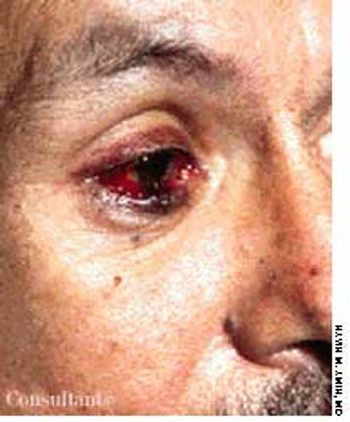
A painful swelling over the right lower eyelid with conjunctival injection was evaluated in a 28-year-old injection drug user. Cephalexin and corticosteroid ophthalmic drops failed to resolve the condition.
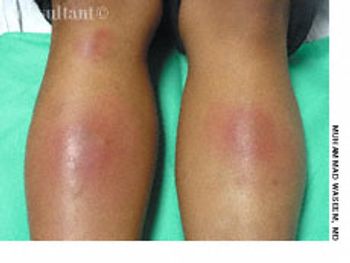
A 16-year-old girl had had tender, erythematous, nodular, shiny lesions on the extensor aspect of both shins for 2 weeks. There were no ulcerations or adenopathy. She denied fever, cough, sore throat, pruritus, and GI symptoms. Aside from oral contraceptives, she was not taking any medications.
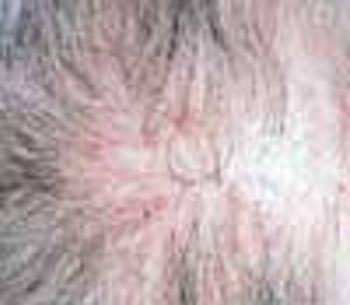
This unusual manifestation of lichen planus is marked by inflammation around the follicular epithelium; on closer examination, erythematous follicular papules may be identified.

A mass on the right side of her face-over the right parotid region-had been growing for the past 4 years, according to this 65-year-old woman. There was no evidence of facial nerve involvement.
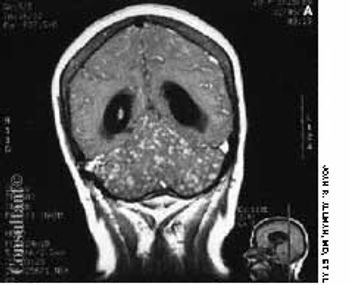
A comatose 29-year-old woman was brought to the emergency department. Her family reported that she had been well until 4 days earlier, when headache and fever developed. She went to another hospital at that time and was told she had an abscessed tooth. She was given erythromycin, and the tooth was extracted the following day. The patient's headache and fever worsened; a sore throat also developed, and a rash appeared on her trunk, arms, and legs. The family denied any HIV risk factors, unusual medical history, recent travel, and exposure to persons with infectious diseases.
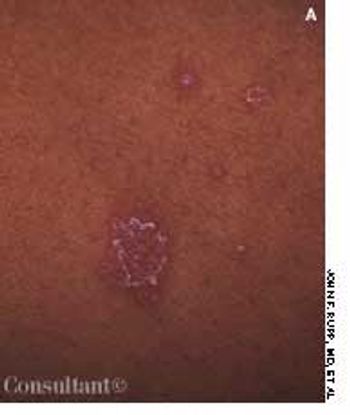
This self-limited eruption is characterized by erythematous, scaling, oval-shaped macules on the trunk and proximal extremities. Most outbreaks begin with a single, large patch-a mother or herald patch-that typically is found on the trunk. Commonly, this lesion is confused with ringworm.
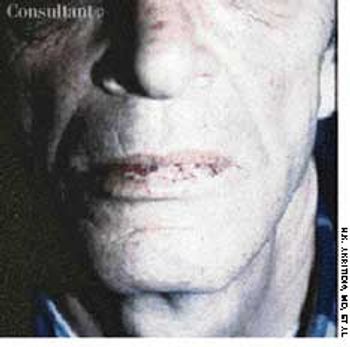
A 62-year-old man was admitted to the hospital with iron deficiency anemia, as demonstrated by low serum iron and ferritin levels and high total iron–binding capacity. He had had this condition for at least the last 5 years and had been treated with ferrous sulfate sporadically. The history coupled with the laboratory findings and the telangiectatic lesions on his lower lip led to a diagnosis of hereditary hemorrhagic telangiectasia, or Rendu-Osler-Weber disease.

Enlarging, coin-shaped lesions erupted on a 54-year-old man's posterior hands, arms, and buttocks 3 weeks before he sought medical evaluation. A few scattered lesions arose on his trunk and thighs as well. The lesions were mildly pruritic, but there were no excoriations. No discharge from the lesions was observed. The patient's history revealed no causative environmental factors.
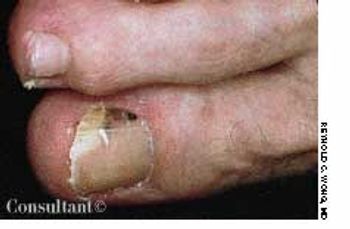
A 45-year-old woman who had had several melanomas removed was concerned because of hyperpigmentation beneath her toenail. Some distal onycholysis was also noted. Because of the patient's history and the fact that she could not definitely recall injuring the toe, a partial nail evulsion was performed. Fortunately, the only finding was dried blood.
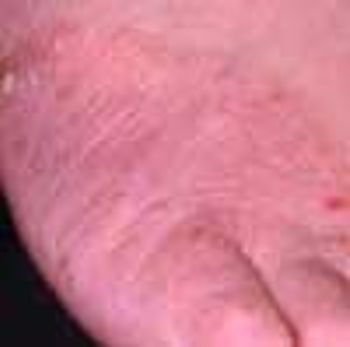
A pruritic rash of unknown origin had been present on the dorsum of a 26-year-old woman's foot for several months. Despite oral antibiotic therapy and applications of antifungal creams and topical corticosteroids, the condition did not resolve.
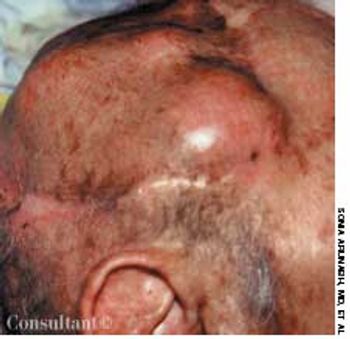
An 85-year-old man was admitted to the hospital with a cough and shortness of breath of 1 week's duration and a fever and increased sputum production for 2 days. His history included renal cell carcinoma and metastatic renal cancer for 2 years. The patient had smoked cigarettes for 30 years. He had lost 30 lb during the last few months.
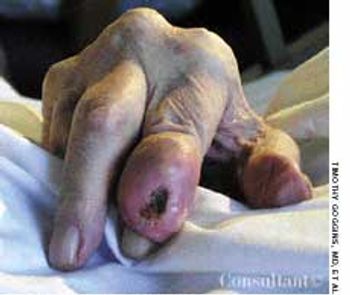
An 80-year-old man, who could not walk because of a large mass on his right leg, was brought to the emergency department. The mass had been increasing in size on the anterior region of his right thigh for approximately 6 months. The patient also complained of “lumps” that had developed on his extremities during the past 2 months.
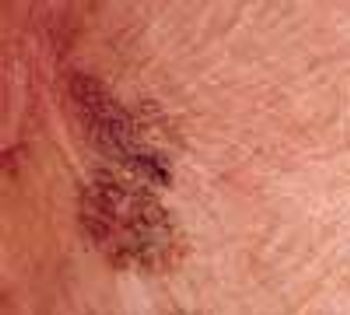
Recurring blisters on the sides of the fingers brought a 72-year-old man to his physician. He was asked to change into a gown for a full-skin examination. Physical examination demonstrated minute papulovesicles affecting the medial and lateral aspects of the fingers, consistent with dyshidrosis. The patient's skin was severely sun-damaged, and there was an irregularly pigmented, asymmetric patch affecting the posterolateral neck.
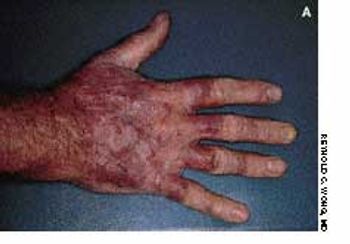
A 45-year-old man had a red, somewhat annular, slightly scaly plaque studded with red nodules that covered the back of his right hand. Nail dystrophy was evident on the middle finger. The patient's left hand was free of lesions, but the soles of both feet were slightly red and scaly, and there was an annular, serpiginous border on the left foot.

For the past 3 years, comedones, papules, pustules, and nodules had been erupting on the face of a 16-year-old boy. Acne vulgaris had been diagnosed. Topical tetracycline cream and oral tetracycline were used without success.
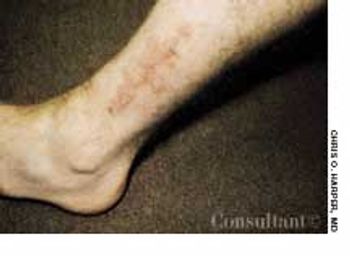
A 27-year-old man presented with intensely pruritic, violaceous, flat-topped papules on the lateral aspect of his left leg. He reported that the lesions developed a few weeks after the area was severely scraped in an accident several months earlier.

For the past 2 days, a 30-year-old man had experienced scant hemoptysis. He had also lost a significant amount of weight-5 kg (11 lb)-over the last 2 months. The patient, a recent emigrant from Ecuador, had no history of tuberculosis (TB) or of exposure to this disease, and he had not been skin tested with purified protein derivative (PPD). He denied exposure to risk factors for HIV infection.
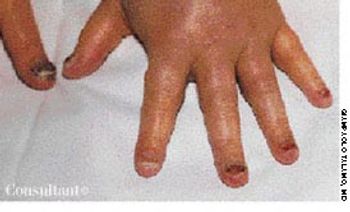
A 54-year-old woman with breast cancer metastatic to the lungs had been treated with four courses of docetaxel, to which she partially responded. Following the first cycle of chemotherapy, the patient experienced arrested growth of her fingernails and toenails. Progressively worsening onycholysis then developed.